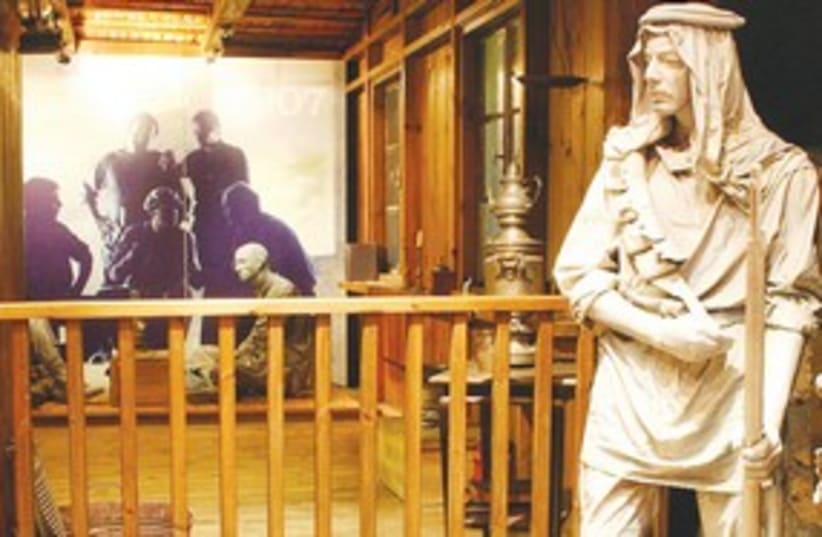Phone: (03) 560-8624 Fee: NIS 15/10. Wheelchair accessibleIZL MuseumDespite the efforts of the Hagana, Jews found themselves defenseless during massive Arab riots in 1921 (Tel Aviv) and 1929 (Jerusalem and Hebron, when 133 Jews were massacred and 230 injured in the course of one week).In the early 1930s, some members of the Hagana grew impatient with its policy of self-restraint and formed a paramilitary force called Irgun Zva’i Leumi. They believed in retaliation against the Arabs as well as actions meant to drive the British out of Israel, so as to hasten the establishment of a Jewish state.Many people feel that the activities of the IZL during the crucial pre-state years were instrumental in the British decision to toss the Palestine question onto the stage of the United Nations. But not everyone realizes that IZL soldiers also played an important role in Israel’s War of Independence, especially during the fierce battle for Jaffa and the brutal fight to recover Ramat Rahel from its Arab conquerors.You will learn all about the IZL underground movement and the part it played in the history of the state during a visit to the striking IZL Museum, located at the southern end of the Tel Aviv seaside promenade.Much of the museum’s design is symbolic, blending the old and the new. Originally a khan, or caravansary, in the Manshiya neighborhood of Jaffa, its kurkar (sealimestone) walls have been strengthened and the building was finished with glass.Three-dimensional exhibits, a sound-and-light presentation, and unusual features offer you an unforgettable glimpse into the recent past. Look for a model of a prestate defensive position for protecting settlements. And don’t miss a great new movie with authentic shots from the period.IZL veterans are especially proud of the organization’s part in the ferocious three-day battle over Jaffa, then a large Arab city. To learn about the innovative approach they used, read the explanations and watch the fourminute (Hebrew only) film.During Succot, the museum will offer guided tours every two hours in Hebrew, and activities and movies for children all day long. Also, and unique to this museum, a special kiosk provides English-speaking visitors with extra information and movies in English.Hours: Sun.-Thurs., 8 a.m-4 p.m.Phone: (03) 517 7180 Fee: NIS 15/10. Wheelchair accessibleIDF MuseumLocated next to the Tahana Complex between Neveh Tzedek and the sea, the IDF Museum is one of Israel’s finest salutes to our heritage.Its wonderful assortment of exhibits, both indoors and out, presents visitors with a complete history of the Israel Defense Forces from its very beginnings until the present time – a nostalgic and inspiring journey.Visitors can climb inside one of the actual armor-plated buses that brought personnel to Mount Scopus before and after the division of Jerusalem in 1948.Examine a collection of over 550 types of hand gun, many sent by Jews from all over the world just before the outbreak of the War of Independence. You will view personal equipment and uniforms issued to soldiers way back in 1948, and see a display of captured enemy vehicles from Israel’s wars.One exceptional pavilion holds weapons and other equipment used by Arab terrorists. Another displays two enormous coastal guns that the Egyptians positioned in 1956 near the Straits of Tiran just before the Sinai Campaign. A third demonstrates where it all began (from 1920 to 1948), while a fourth features official cars – such as the vehicle which carried Brigade Commander Motta Gur into the Old City after the liberation of Jerusalem.Hours: Sun.-Thurs. 8:30 p.m.-3 p.m.
Phone: (03) 517-2913, (03) 516-1346 Fee: NIS 15/10. Wheelchair accessible Important: you can buy a combined ticket for five Tel Aviv Defense Ministry Museums at any of them that is good for a month, and costs only NIS 20/15.JERUSALEMMuseum of Underground PrisonersIn 1864, after buying a large plot of land outside the walls of Jerusalem’s Old City, the Russian Orthodox Church built a pilgrims’ hostel for women.Early in the British Mandate, the long, squat building was turned into a jail for thieves and murderers; later, Jews were thrown into the prison for defending themselves, carrying weapons, belonging to the underground, and terrorizing the British.For decades after the founding of the state, its history forgotten, the prison provided office space and storage for different institutions. Later, former inmates transformed the building into a shrine for Hagana, IZL and Lehi fighters hanged by the British and called it Hechal Hagevura (Hall of Heroism).Eventually, recognizing the underground’s significant part in the nation’s history, the Defense Ministry restored the building. Today it serves as the Museum of Underground Prisoners, telling the spellbinding story of a relentless struggle to oust the British and help create a Jewish state.Several of the bleak cells have been restored along with the bakery, workshops and a makeshift synagogue. The exercise yard, now empty, of course, is where prisoners about to be flogged were tied to a wooden structure that stood in the corner.One cell holds two “attractions”: names, mottos and inscriptions that prisoners chiseled into the floor, and the open hatch under one of the beds through which 12 Jewish prisoners managed to escape.Fifteen members of the underground who were incarcerated at the Jerusalem Central Prison were sentenced to death. Nine sentences were commuted to imprisonment, but six men were scheduled to hang.In the execution chamber, you will see the gallows and the red uniforms worn by prisoners condemned to death. However, no Jewish prisoner was hanged in this room. That’s because the British feared violence on the part of Jewish Jerusalemites and took four of the condemned to Acre Prison. They were executed at dawn on April 17, 1947, and went to the gallows singing “Hatikva.”On April 21, just hours before they were scheduled to hang, the other two blew themselves up with a grenade that had been smuggled into the prison, inside an orange.Hours: Sun.-Thurs. 9 a.m.-5 p.m.; during Hol Hamoed Succot from 9 a.m.-6 p.m. Phone: (02) 623-3166.
Fee: NIS 15/10.
